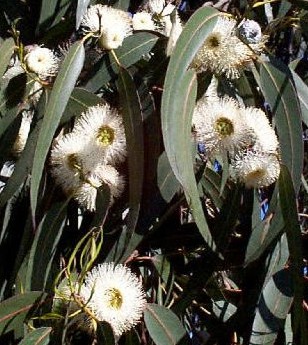|
Gardens Ablaze |
||
|
|
Eucalyptus |
|
|
Additional Eucalyptus Information
Medicinal Uses Site Map
Home Mastergardening.com has a large variety of worm composters, garden composters and aeration composters. Free Shipping over $100.
Mastergardening.com has all the newest gadets for improving your garden. Let technology make gardening easy.
Mastergardening.com has a new line of outdoor garden decor to beautify your garden and backyard. |
The Eucalyptus genus encompasses over 500 different plants and offers a wide diversity in leaf shape, bark color, and flowering habit. Eucalyptus grows rapidly, often over 10 feet per year, and because of its unique Vicks VapoRub scent, it is useful in controlling insect pests including aphids. Once established in a proper setting, it is a carefree and very attractive year-round addition to the landscape. A few tropical Eucalyptus types have showy flowers, but most have rather non-descript white or off white flowers that really don't add much in the way of ornamental value. The foliage, however, is remarkable and quite diverse, with a silvery look that can be seen from quite a distance, and cut foliage makes a wonderful addition to cut flower bouquets. When shopping for a Eucalyptus tree for the home landscape, think small. These trees have extraordinarily sensitive root systems, and growth for a pot-bound plant may be stunted for years to come. Therefore, choose a small seedling that has a sturdy root system that is not coiled on the bottom of the pot. Tease the root ball a little to encourage spreading, and plant the seedling in prepared soil away from competing plantings, especially grass. Choose the site carefully, as Eucalyptus prefer a very well-drained soil in full sun, but with a bit of shelter from strong or cold winds. Those with seaside locations can grow Eucalyptus with ease, as it is quite salt tolerant, but do give it some shelter from strong winds in this situation. Eucalyptus has a swollen tuber-like root that allows for regrowth after catastrophic events such as fires. As long as this tuber is not allowed to freeze, the tree can regrow regardless of what has happened to it above the surface. Therefore, when planting a Eucalyptus, plant deep and mulch heavily. Unlike most trees, The Eucalyptus does not mind having part of its trunk buried, and planting deep will help protect the tuber from frosts. Water generously and fertilize regularly until the plant matures - if you let it get too dry even for a short time, you will stunt the growth or kill the plant entirely. Once mature, it will be amazingly drought tolerant and pest-free, though it still appreciates a drink in very dry conditions. Eucalyptus can be planted at any time of year, but in colder regions, springtime is probably the best bet, because it will give the plant time to become established before it has to face the hardships of winter. However, even if you find yourself with a seedling in the dead of winter, get it in the ground as soon as possible, mulch very heavily, and cross your fingers, because leaving it in the pot to become root bound while waiting for spring is going to end in a stunted plant that for sure won't do well anyway. Eucalyptus is a member of the Myrtle family, and is also known by the names Blue Gum Tree and Fever Tree. The tallest known specimen is in Tasmania and tops out at 322 feet!
Custom Search
|
|
|
Gardens Ablaze |
||
 If
you live in a relatively temperate zone (zone 6 and up) and are looking
for a truly eye-catching specimen tree, you can't go wrong with Eucalyptus.
With its silvery leaves, red stems, and interesting white, gray, flaking,
or snake skin bark, Eucalyptus in the landscape is sure to draw comments
and compliments.
If
you live in a relatively temperate zone (zone 6 and up) and are looking
for a truly eye-catching specimen tree, you can't go wrong with Eucalyptus.
With its silvery leaves, red stems, and interesting white, gray, flaking,
or snake skin bark, Eucalyptus in the landscape is sure to draw comments
and compliments.